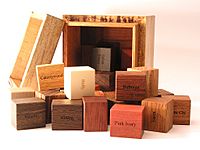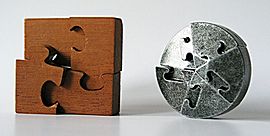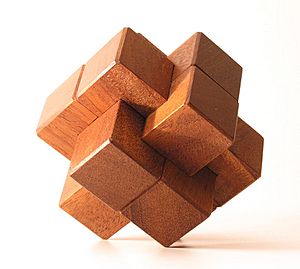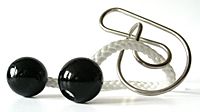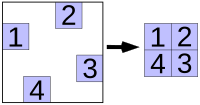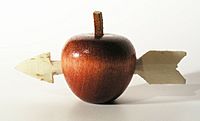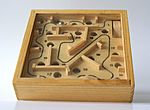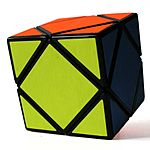Mechanical puzzle facts for kids
A mechanical puzzle is a puzzle made of pieces that fit together. To solve it, you need to move the whole object or its parts. One of the most famous mechanical puzzles is the Rubik's Cube, invented by Ernő Rubik in 1974. Most mechanical puzzles are for one player. The main goal is to understand how the puzzle works, not just to solve it by luck. Because of this, they are often used to test intelligence or help with problem-solving skills.
Contents
Types of Mechanical Puzzles
Assembly Puzzles
In this type of puzzle, you get separate pieces. Your goal is to put them together to make a certain shape. Good examples include the Soma cube by Piet Hein and the Pentomino by Solomon W. Golomb. The well-known Tangram and "Anker-puzzles" are also assembly puzzles.
Some assembly puzzles involve fitting many pieces into a box that seems too small. The image shows Hoffman's packing puzzle. Here, you need to fit 27 smaller blocks (cuboids) into a larger box. The trick is that the smaller blocks have different side lengths.
Today, tools like laser cutters help create amazing 2D puzzles from wood or plastic. These puzzles often have beautiful, repeating patterns. Computers also help design new puzzles. They can make puzzles with very few solutions or ones that need many steps to solve. This makes them very challenging!
Some puzzles use clear materials. You stack pieces on top of each other to create a specific pattern or color design. For example, one puzzle uses colored discs that you stack to form a color circle.
Disassembly Puzzles
These puzzles are usually solved by taking them apart or opening them. This includes puzzles with secret opening methods. You often have to try different things to find the hidden way to open them. Puzzles made of several metal pieces linked together also fit into this group.
The two puzzles in the picture are great for parties. They look easy to take apart, but many people struggle with them. The pieces have slanted edges that only allow them to be removed in one direction. But each piece has two opposite slants, making it hard to pull them apart.
Secret boxes, also called puzzle boxes, are very popular in Japan. These boxes have clever, often hidden, ways to open them. Once open, they usually reveal a small space inside. There are many different opening methods. Some have tiny panels to slide, others use tilting, magnetic locks, or pins that need to be turned. Some even have time locks where you hold an object in place until a liquid fills a container.
Interlocking Puzzles
In an interlocking puzzle, one or more pieces hold the others together. Or, the pieces support each other. The goal is to take the puzzle completely apart and then put it back together. Both steps can be tricky! Unlike assembly puzzles, these usually don't just fall apart. The difficulty is often measured by how many moves it takes to remove the first piece. Later puzzles added twisting movements.
These puzzles have been around since the 1700s. A catalog from 1803 showed two such puzzles. Professor Hoffman's puzzle book also featured two interlocking puzzles.
In the early 1800s, the Japanese became leaders in these puzzles. They created many different shapes, like animals and houses. In the Western world, the puzzles mostly stayed as geometric shapes.

Computers have helped analyze these puzzles. Bill Cutler used computers to study all the Chinese wood knots. From 1987 to 1990, computers analyzed over 35 billion different versions! With shapes different from the Chinese cross, some puzzles need up to 100 moves to remove the first piece. This is very hard for humans to figure out.
Stewart Coffin has been making puzzles since the 1960s based on the rhombic dodecahedron. These puzzles often have oddly shaped pieces that only form a regular shape at the very end. Some designs also require several pieces to be moved at the same time. The "Rosebud" puzzle is an example where six pieces must be moved together to the center.
Disentanglement Puzzles
For these puzzles, your goal is to free a metal or string loop from an object. Topology, which is about shapes and spaces, is important here. The image shows a "derringer puzzle." It looks simple but is very hard. Many puzzle websites rank it as one of their toughest.
Vexiers are another type of disentanglement puzzle. They involve two or more twisted metal wires that you need to untangle. They became popular in the late 1800s. Many Vexiers you see today are from that time.
Ring puzzles, like the Chinese rings, are also Vexiers. In these, you must free a long wire loop from a mesh of rings and wires. The number of steps needed to solve them often grows very quickly with more loops. The common type, which connects rings to a bar, moves like a special binary code.
The Chinese rings puzzle is also known as Cardans' rings or the Baguenaudier. It was mentioned around 1500 in a manuscript by Luca Pacioli. Gerolamo Cardano also wrote about it in 1550. Even though it's a disentanglement puzzle, it also has mechanical parts. You can solve it using a binary math process.
There's a story that in the Middle Ages, knights gave Chinese rings to their wives to keep them busy while they were away. Tavern puzzles, made of steel, came from blacksmith apprentices practicing their forging skills.
Niels Bohr used disentanglement puzzles called Tangloids to show his students how spin works in physics.
Fold Puzzles
The goal in these puzzles is to fold a printed piece of paper to create a target picture. Rubik's Magic could be seen as a fold puzzle. A better example is shown in the picture. You need to fold the square paper so that the four numbered squares touch each other without gaps, forming a new square.
Folding maps or brochures can also be a puzzle! Even with visible fold lines, it can be very hard to fold them back to their original state. This is because the folds are often designed for machines, not for people to fold easily.
Lock Puzzles
These puzzles are also called trick locks. They are locks, often padlocks, with unusual locking systems. The goal is to open the lock. If you get a key, it won't open the lock in the normal way. For some, it might even be harder to put the lock back to its original locked state.
Trick Vessels
These are containers with a "twist." The goal is to drink from them or pour liquid out without spilling. Puzzle containers are a very old type of game. The Greeks and Phoenicians made containers that had to be filled from a hole at the bottom. In the 800s, a Turkish book described many different containers. The Chinese also made these drinking containers in the 1700s.
One example is the puzzle jug. The neck of the jug has many holes, so you can pour liquid in, but not out. Hidden from view, there's a small tube running through the handle and along the top rim to the spout. If you block the opening at the top of the handle with your finger, you can drink from the spout by sucking.
Other examples include the fuddling cup and the pot crown.
Impossible Objects
Impossible objects are things that seem impossible to make at first glance. The most famous one is the ship in a bottle. The puzzle is to figure out how these objects were made. Another well-known puzzle is a cube made of two pieces that seem stuck together in four places. The solutions to these puzzles are often clever tricks. There are many types: bottles with objects too big to fit through the opening, Japanese coins with wooden arrows through them, or wooden spheres inside frames with holes that are too small.
The apple and arrow in the picture are each made from a single piece of wood. The hole in the apple is too small for the arrow to pass through, and there are no signs of glue.
Dexterity Puzzles
These games are not strictly puzzles because they rely more on your skill and patience. Often, the goal is to tilt a box with a clear cover just right. This makes one or more small balls fall into specific holes.
Sequential Movement Puzzles
Puzzles in this group need you to repeatedly move parts of the puzzle to reach a certain goal. Famous examples include the Rubik's Cube and the Tower of Hanoi.
This category also includes puzzles where you slide one or more pieces into the correct spot. The N-puzzle is the most famous of these. Rush Hour and Sokoban are other examples.
The Rubik's Cube started a huge craze for this type of puzzle. Many different versions have been made. There are cubes from 2x2x2 up to 33x33x33! There are also other shapes like tetrahedrons and dodecahedrons. By changing how the puzzle twists, many different puzzles can be made from the same basic shape. You can also get new puzzles by removing a layer from a cube. These puzzles take on strange shapes when you mix them up.
The picture shows another, less common, sequential movement puzzle. It's easy enough to solve with some trial and error, unlike the Rubik's Cube, which is too hard for just guessing.
Simulated Mechanical Puzzles
Many computer games and puzzles on computers copy mechanical puzzles. However, these simulated mechanical puzzles are usually not called "mechanical puzzles" in the strict sense.
Other Cool Mechanical Puzzles
- Chinese Ring Puzzle: A puzzle with iron rings that you manipulate in a specific order (very old).
- Nintendo Ten Billion Barrel: You move connected parts of a barrel.
- Hedgehog in the Cage: A popular mechanical puzzle from the Czech Republic.
See also
 In Spanish: Rompecabezas mecánico para niños
In Spanish: Rompecabezas mecánico para niños



